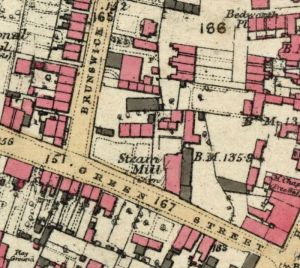Steam Corn Mill, Green Street, Ryde
The Steam Corn Mill, in Green Street, Ryde, Isle of Wight was reputedly built in 1845 and run for sometime by Mr. Robert Way of Carisbrooke[1].
The Steam Mill was on the north side of Green Street, situated between Station Street (originally Brunswick Place) and the High Street.
In 1861 as a notice announced that John Souter of the Wind Mill at Upton had taken over the Steam Mill[2].
Reports from 50 local residents, and the Inspector of Nuisances, of a nuisance caused by smoke from the steam mill was laid before Ryde Town Council in 1876. When Mr. Way, the owner, (seems to conflict with the 1861 notice above), was spoken to, he was reported as responding “The mill was here before your houses; you have come to the nuisance, not the nuisance to you.” The newspaper records that Mr. Way had tried some smokeless coal[3]. Late it was reported at the Ryde Petty Sessions that a summons against Mr. Robert Way, for committing a nuisance at his Steam Mill … [was] settled out of court[4].
In 1891 a report of a theft of a drum from the practice room of the Ryde Drum and Fife Band indicate that the band had a practice room in the steam mill[5].
The steam mill went to auction in July 1895, it comprised:
|
On the top floor, eight wheat bins, elevator, storage-room, and staging ..; |
The steam mill was again put to auction in 1900[7].
In 1936 the site, which was identified as 18 and 19 Green Street, was sold on behalf of J. G. Duffett, deceased, and identified as a store[8].
In 1972 a demolition order was issued on the site, then owned by Mr. A. P. Reed, on the grounds that the building had become unsafe. In the newspaper announcement, it was recorded that the mill had become a slaughterhouse until the end of the 1920's, then the management of the Theatre Royal had used it as a props store. [1].
The whole site, together with demolished neighbouring buildings, was used as a council car park for a number of years. In 2009 the edges of the site facing Green Street and Station Road were developed with housing.
- ↑ 1.0 1.1 Isle of Wight County Press - 30 September 1972
- ↑ Isle of Wight Observer - 20 July 1861
- ↑ Isle of Wight Observer - 16 September 1876
- ↑ Isle of Wight Observer - 23 September 1876
- ↑ Isle of Wight County Press - 23 May 1891
- ↑ Isle of Wight County Press – 29 July 1895
- ↑ Isle of Wight Observer – 19 May 1900
- ↑ Isle of Wight County Press - 30 May 1936
